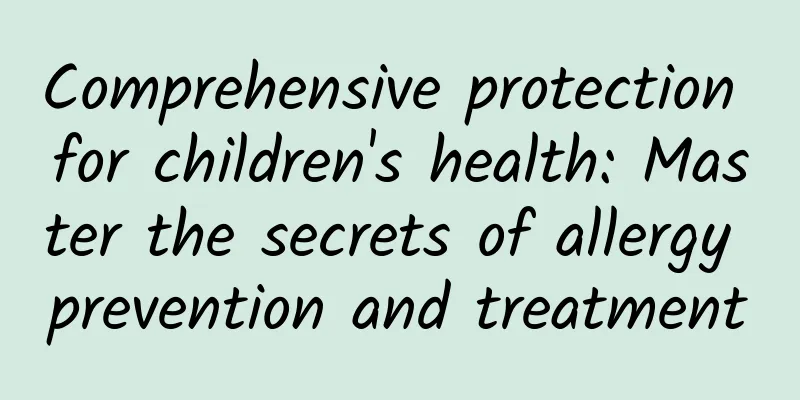Comprehensive protection for children's health: Master the secrets of allergy prevention and treatment

|
Author: Yu Xingmei Children's Hospital Affiliated to Suzhou University Reviewer: Hao Chuangli, Chief Physician, Children's Hospital Affiliated to Soochow University "My baby has a rash again," "My baby is allergic to milk and eggs," "My child has rhinitis, which breaks out in the spring!" "My child has asthma, which is also allergic." There are thousands of allergies, which one will your baby be prone to? Figure 1 Copyright image, no permission to reprint Worldwide, the incidence of allergic diseases is showing a clear upward trend, and allergic diseases seem to have become an "epidemic". Many mothers are anxious and confused. Allergies not only affect children's daily lives, but also harm their physical and mental health. Allergic diseases include food allergies, atopic dermatitis, allergic rhinitis and allergic asthma. The World Allergy Organization has designated July 8 of each year as World Allergy Day to enhance the public's awareness of allergic diseases. So, what are the secrets to preventing and treating allergies? 1. What are allergic diseases? Allergic diseases are a group of diseases caused by the body's immune system's hypersensitivity to typical harmless substances in the environment, including allergic rhinitis, atopic dermatitis, allergic asthma, food allergies and severe allergic reactions. The manifestations of allergic diseases in children at different stages are different. In infancy, it usually manifests as eczema or food allergies. The above symptoms will improve on their own around the age of 3, but respiratory allergic diseases will gradually appear, manifested as rhinitis and asthma. This process is the natural progression of allergic diseases. 2. How to identify whether you have allergic asthma/rhinitis 1. When children often cough and wheeze when they wake up in the early morning or when seasons change, you should suspect that they have asthma. 2. If your child often experiences unexplained nasal itching and stuffiness, followed by continuous sneezing and clear nasal discharge when waking up in the morning, you should be alert to whether he or she has allergic rhinitis. If you suspect your child has asthma or allergic rhinitis, you should consult a specialist. The doctor will ask about your child's condition and make a diagnosis after conducting relevant tests. Figure 2 Copyright image, no permission to reprint 3. What are the common allergens in life? 1. Inhaled allergens such as pollen, catkins, dust, insect mites, cold air, animal dander, oil smoke, various spices, etc. 2. Food allergens such as seafood, fish, shrimp, dairy products, soy products, flour, wheat, nuts, dried fruits, etc. 3. Contact allergens such as cosmetics, hair dyes, paints, cold air, hot air, ultraviolet rays, radiation, bacteria, mold, viruses, parasites, etc. 4. Other types of allergens, such as injectable drugs such as penicillin, streptomycin, xenobiotic serum, etc. 4. How to avoid dust mites Dust mites have become one of the main harmful organisms in life and are the main culprits for asthma, rhinitis and many skin diseases. According to statistics, asthma patients caused by dust mites account for 70% to 80% of the total number of allergy patients. Dust mites are a type of harmful arthropod that is hard to see with the naked eye. They mainly feed on skin flakes. Dust mites can be found wherever people live. These small creatures can get into almost any place, especially beds, corners in the house, carpets, and bedding. "There are often more than 2 million mites living in our beds, and 4,000 of them can be killed by stepping on them." The allergenicity of dust mites has been recognized both at home and abroad. Whether it is live mites, dead mites, or dust mite feces balls, they are very strong allergens. They fly into the air when making beds, folding quilts, and sweeping the floor, and when inhaled by people with allergies, they trigger allergic reactions. Measures to avoid indoor allergens such as dust mites: ① Keep the room ventilated; ② Reduce the use of plush toys and synthetic blankets; ③ Bedding: soak and rinse in 55-60 ℃ water, expose to the sun for 5-6 hours and pat; ④ Use anti-mite bedding. Figure 3 Copyright image, no permission to reprint Life tips : Allergies are no small matter. Prevention is the key to allergies. After identifying the allergens, we should effectively reduce the concentration of allergens in the environment and avoid allergies as much as possible. If an allergic reaction occurs, don't panic, respond rationally, seek medical treatment as soon as possible, and receive standardized treatment. References Editorial Board of Chinese Journal of Pediatrics, Chinese Medical Association Pediatrics Branch. Expert consensus on diagnosis and treatment of allergic diseases in children[J]. Chinese Journal of Pediatrics, 2019, 57(3): 164-171. |
<<: The latest research: Gaining weight really makes people stupid!
>>: Can athlete's foot be cured by walking in the dirt? Not recommended!
Recommend
Interesting Medicine Talk | Isatis Root Granules
Your browser does not support the audio tag...
Is it normal to have a small amount of bleeding during pregnancy?
Regarding the symptoms during pregnancy, I believ...
What should pregnant women do if they smell floral water?
Floral water is a product that is often used in s...
What causes hypothyroidism in women?
Everyone has a certain probability of suffering f...
Why are my periods getting less and less frequent?
Menstruation is a normal physiological phenomenon...
Official data from Kuaidi Taxi: In the first quarter of 2014, drivers collected more than 4.73 billion yuan in fares through Kuaidi Taxi
On April 2, Kuaidi Dache announced its first quar...
What is the cause of belly button pain?
The belly button is most easily overlooked by eve...
What are the benefits of guava juice? How to squeeze guava juice
Guava juice is the most suitable drink for women....
How long do you usually take Chinese medicine for gynecological treatment?
In the treatment of many gynecological diseases, ...
22 years old and no menstruation for four months
Menstruation (also known as menstruation, also kn...
What is the cause of blood flow signals in breast nodules?
When female friends feel some discomfort in their...
Where to cut the episiotomy
The process of childbirth for women is like walki...
Bilateral ovarian multilocular changes
There are many diseases that women are prone to, ...
Can I travel two weeks after taking the medicine for medical abortion?
Many people love to travel, but some women cannot...









